[ENG-SPN] The universal language of Architecture: San Baudelio de Berlanga / El lenguaje universal de la Arquitectura: San Baudelio de Berlanga
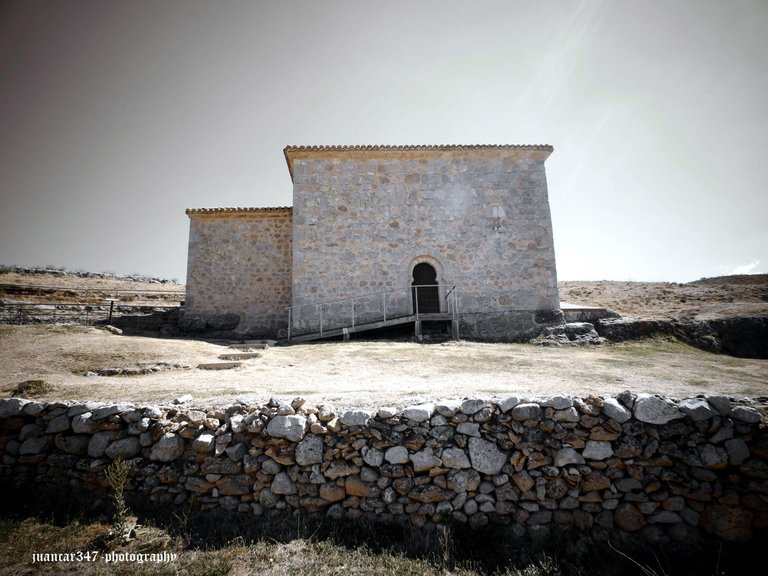
Simple, it doesn't seem like it. In fact, it could perfectly pass through an old and abandoned peasant house, forgotten in the middle of the deserted lands of Berlanga: those same, that at the dawn of the year 1000, knew the passage of bellicose leaders, such as Almanzor or relevant mercenaries, turned into national heroes, like the Cid Campeador.
[A simple, no lo parece. De hecho, podría pasar perfectamente por una vieja y abandonada casa de labriegos, olvidada en mitad de las desiertas tierras de Berlanga: esas mismas, que en los albores del año mil, conocieron el paso de belicosos caudillos, como Almanzor o de relevantes mercenarios, convertidos en héroes nacionales, como el Cid Campeador].

But that false impression that we can form at first is also a great lesson in beauty, humility and design, which I hope will make you share the opinion that, if there is a universal language, it is none other than that of mathematics and mathematics. geometry, applied to architecture.
[Pero esa falsa impresión que podemos formarnos en un primer momento, es también una grandiosa lección de belleza, humildad y diseño, que espero les haga compartir la opinión de que, si existe un lenguaje universal, no es otro que el de las matemáticas y la geometría, aplicadas a la arquitectura].
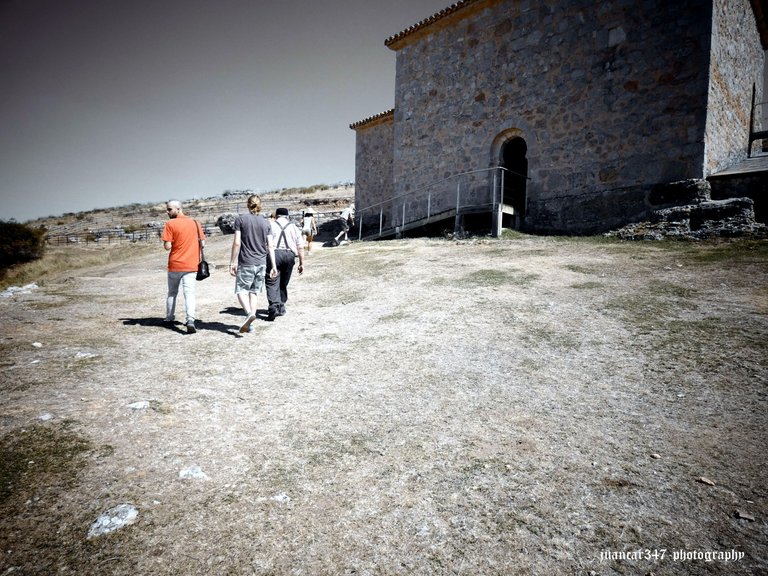
As I say, the history of this building, which is, in reality, the Mozarabic hermitage of San Baudelio de Berlanga, dates back to those dark times at the end of the 9th century, when the superstitious and warrior people of this part of the West, Spain, Not only did they experience the terrible vicissitudes of a clash between cultures, Christian and Muslim, but they also attended, with the fear that the visions of the Apocalypse of Saint John produced in them, at the arrival of the New Millennium, which they considered as the end. of the world, a detail that will possibly be easier for you to understand, taking into account that many of us live the so-called 'Two Thousand Effect' with no little uncertainty.
[Como digo, la historia de este edificio, que es, en realidad, la ermita mozárabe de San Baudelio de Berlanga, se remonta a aquellos oscuros tiempos de finales del siglo IX, cuando las supersticiosas y guerreras gentes de ésta parte de Occidente, España, no sólo vivían las terribles vicisitudes de un enfrentamiento entre culturas, la cristiana y la musulmana, sino que también asistían, con el temor que les producían las visiones del Apocalipsis de San Juan, a la llegada del Nuevo Milenio, que ellos consideraban como el fin del mundo, detalle que les será posiblemente más fácil de entender, habida cuenta de que muchos de nosotros vivimos con no poca incertidumbre el denominado ‘Efecto Dos Mil’].
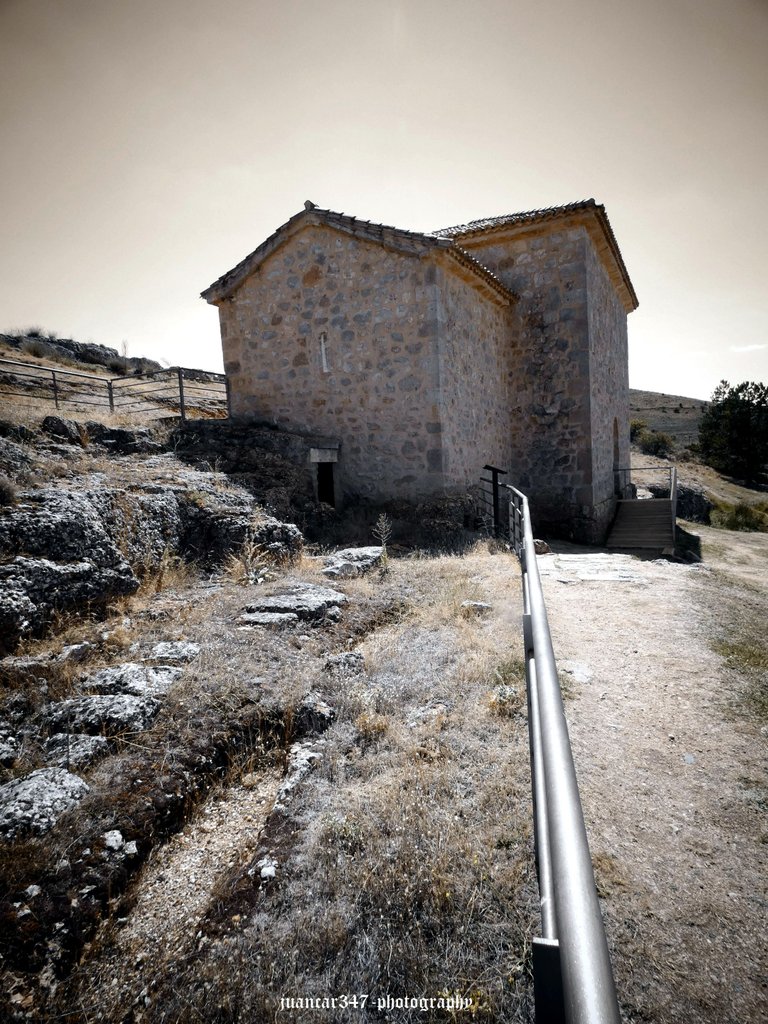
The point is that, in those uncertain times, there were nuclei of Christians, who resided in territory controlled by Muslims and who, by paying the corresponding taxes, were allowed to continue practicing their religious beliefs: the Mozarabs.
[La cuestión es que, en aquellos inciertos tiempos, hubo núcleos de cristianos, que residían en territorio controlado por los musulmanes y a quienes, pagando los correspondientes tributos, se les permitía continuar practicando sus creencias religiosas: los mozárabes].

Precisely, it was a group of Mozarabs, settled in this place, who at that time, under the name of the Duero border, divided Christian Spain from Muslim Spain, who built this temple, which paradoxically contains the best of religious architecture of both.
[Precisamente, fue un grupo de mozárabes, asentados en este lugar, que por aquél entonces, bajo el nombre de frontera del Duero, dividía la España cristiana de la España musulmana, quienes levantaron este templo, que paradójicamente, contiene lo mejor de la arquitectura religiosa de ambas].
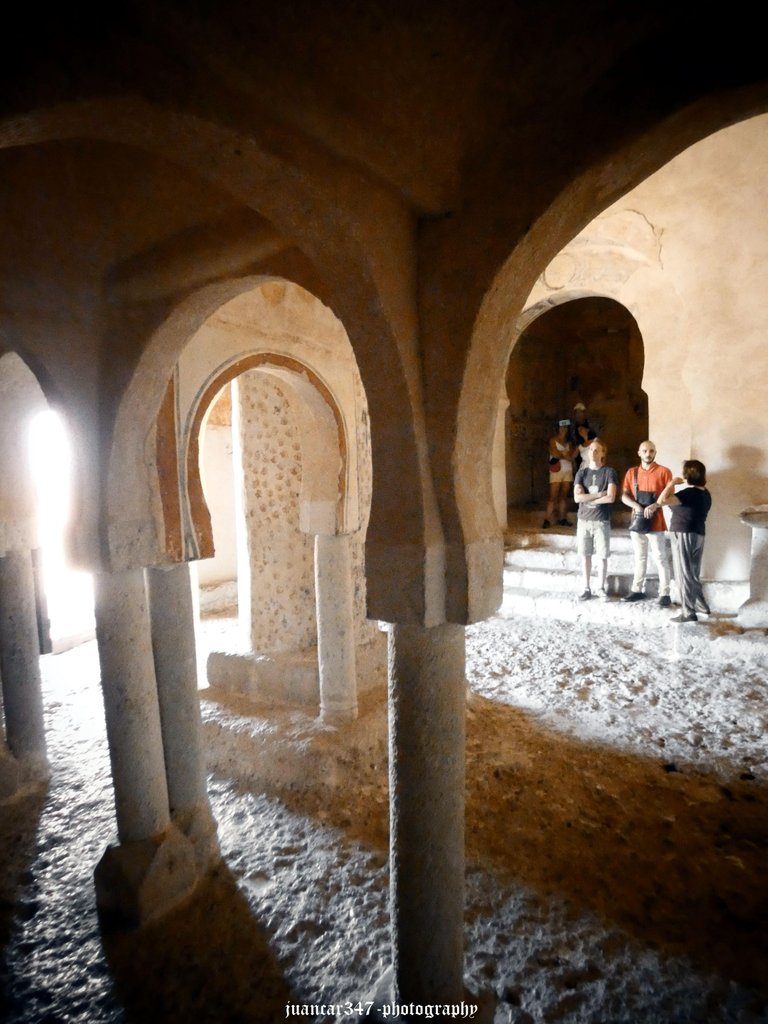
Well, what you are contemplating here, masterfully performed in that universal language that we referred to at the beginning of this post, is a hybrid that combines the characteristics of a Muslim mosque and a Christian church.
[Pues lo que aquí están contemplando, realizado magistralmente en ese lenguaje universal al que hacíamos referencia al comienzo del presente post, es un híbrido que reúne las características de una mezquita musulmana y de una iglesia cristiana].
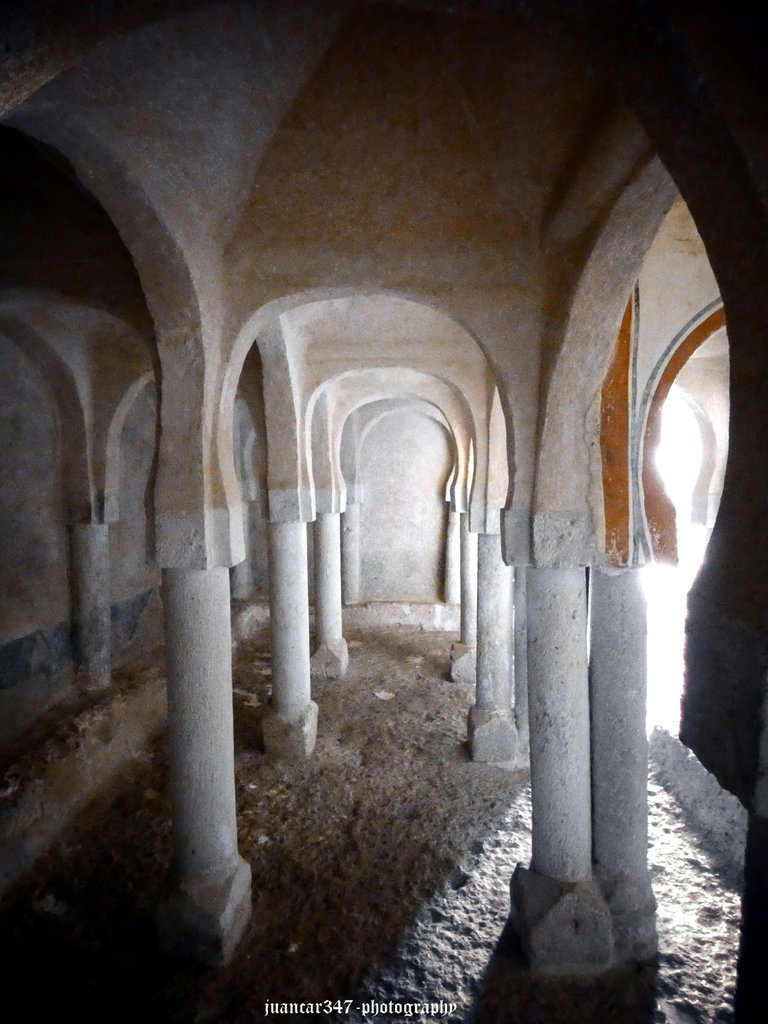
Inside, the monumental and at the same time beautiful palm tree, which, like a true Axis Mundi, supports the vault of the hermitage, stands out for the small forest of columns, typical of Muslim mosques, being characteristic elements of the Christian churches, the altar, oriented towards the East, towards the sunrise - outside and maintaining this same orientation, there was a cemetery with anthropomorphic graves - and the steps, attached to the north side of the nave, which lead to the choir This element, for example, in Asturian pre-Romanesque art, was reserved for kings and celebrities.
[En su interior, llama poderosamente la atención, la monumental y a la vez hermosa palmera, que como un verdadero Axis Mundi, soporta la bóveda de la ermita, sobresaliendo por el pequeño bosque de columnas, típico de las mezquitas musulmanas, siendo elementos característicos de las iglesias cristianas, el altar, orientado hacia el Este, hacia la salida del sol -en el exterior y manteniendo esta misma orientación, había un cementerio con sepulturas antropomorfas- y los escalones, adosados al lateral norte de la nave, que desembocan en el coro, elemento éste, que por ejemplo, en el arte prerrománico asturiano, estaba reservado para los reyes y celebridades].
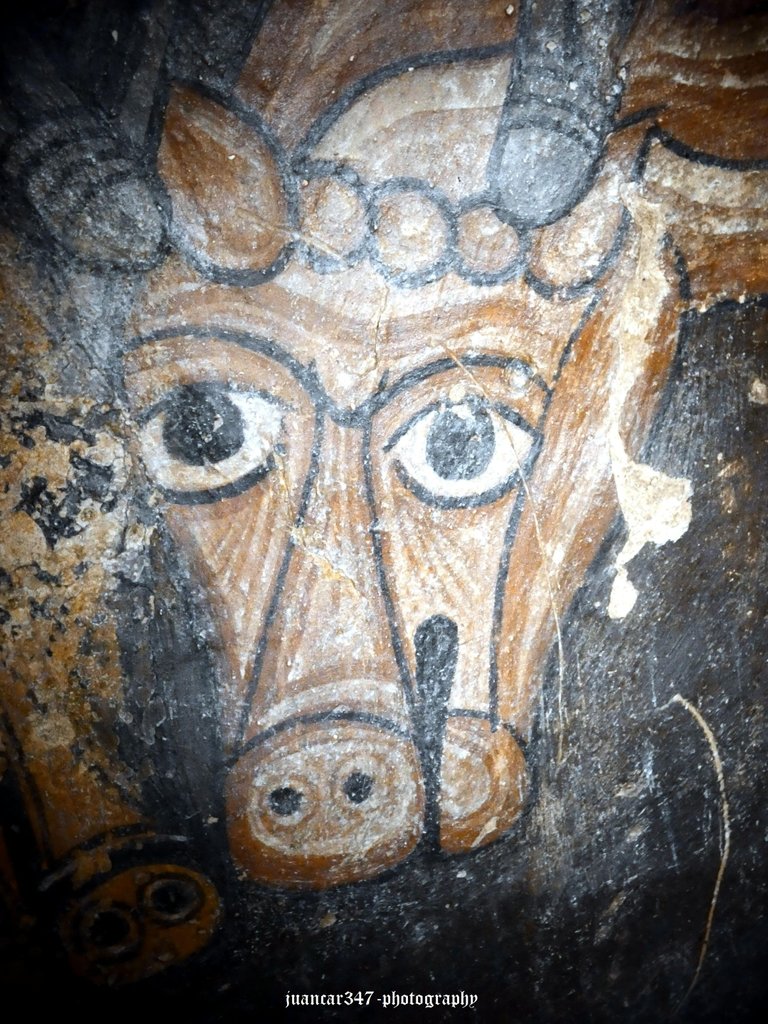
But San Baudelio, even being plundered, hides many secrets: at the bottom of that small mesquite forest and also attached to the north wall, a small nook gives access to a small cave, once dedicated to hermitism.
[Pero San Baudelio, aun estando expoliado, oculta numerosos secretos: al fondo de ese pequeño bosque mezquital y también adosado a la pared norte, un pequeño recoveco da acceso a una pequeña cueva, dedicada en tiempos al eremitismo].

Like many other churches, this Mozarabic hermitage of San Baudelio was also, in its origins, a small Sistine Chapel, decorated with formidable wall paintings - what you can see here are only the marks left when the originals were removed - which were vilely poorly sold and fraudulently taken out of the country in the twenties of last century and today they can be admired in several museums in the United States, including, of course, the famous The Cloister.
[Como muchas otras iglesias, esta ermita mozárabe de San Baudelio, fue también, en sus orígenes, una pequeña Capilla Sixtina, decorada con formidables pinturas murales -lo que aquí pueden observar, son tan sólo las improntas que quedaron al retirarse los originales- que fueron vilmente mal vendidas y sacadas fraudulentamente del país en los años veinte del pasado siglo y hoy se pueden admirar en varios museos de Estados Unidos, incluido, por supuesto, el famoso The Cloister].
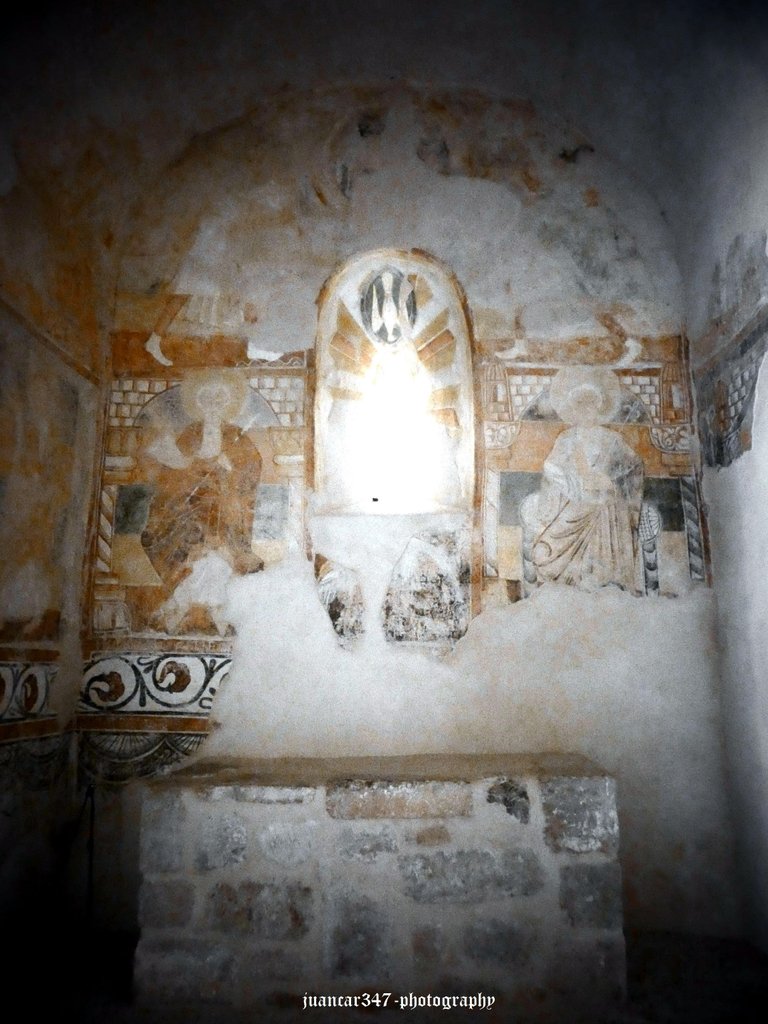
But this part would be a very long story to tell, so, to finish and not abuse your attention, I will propose a little enigma, which still puzzles researchers and historians who deal with the subject: at the top of the pyramid, whose branches are masterfully distributed like Herculean arms supporting the metaphorical sky of the vault, you will observe a small and mysterious nook, whose function, as I say, constitutes a true mystery.
[Pero esta parte sería una historia muy larga de contar, por lo que, para terminar y no abusar de su atención, les propondré un pequeño enigma, que todavía desconcierta a los investigadores e historiadores que tratan el tema: en la cúspide de la pirámide, cuyas ramas se distribuyen magistralmente como brazos hercúleos sosteniendo el metafórico cielo de la bóveda, observarán un pequeño y misterioso recoveco, cuya función, como les digo, constituye un auténtico misterio].

For lovers of medieval literature and more specifically, for those interested in the Arthurian sagas, I will tell you that there is a legend that affirms that the Holy Grail was hidden precisely there.
[Para los amantes de la Literatura medieval y más concretamente, para aquellos interesados en las sagas artúricas, les diré, que existe una leyenda que afirma que ahí, precisamente, estuvo oculto el Santo Grial].
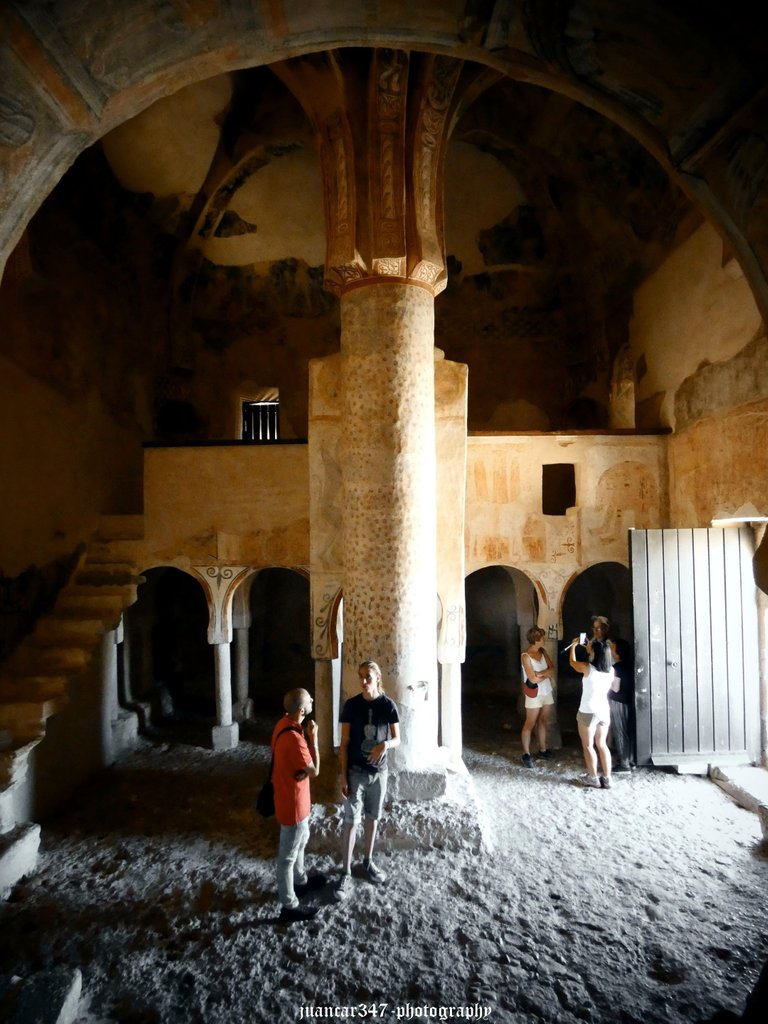
And considering the characteristics, as well as the universal faith of its magnanimous creators, could there be a better place to hide such an important spiritual legacy?.
[Y vistas las características, así como la fe universal de sus magnánimos creadores, ¿cabría otro lugar mejor para ocultar tan importante legado espiritual?].
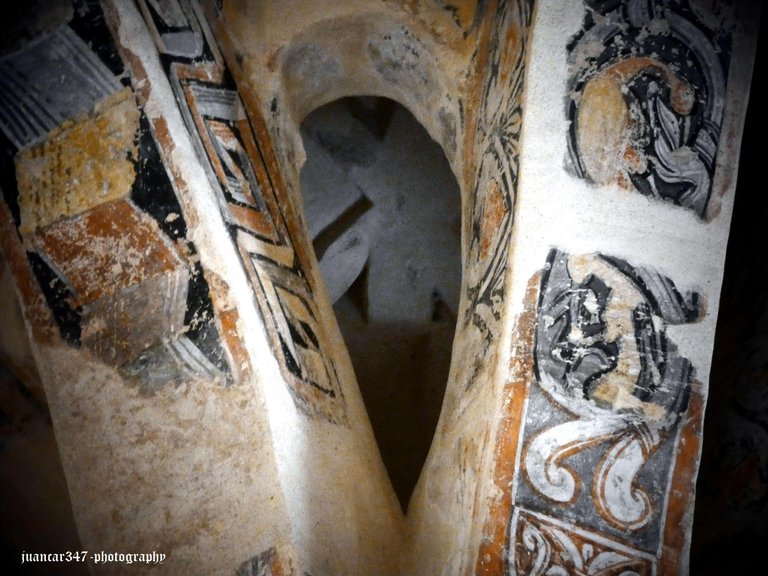
NOTICE: Both the text and the accompanying photographs are my exclusive intellectual property and therefore are subject to my Copyright.
AVISO: Tanto el texto, como las fotografías que lo acompañan, son de mi exclusiva propiedad intelectual y por lo tanto, están sujetos a mis Derechos de Autor.

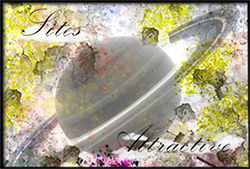



Thank-you very much to @qurator and specially @ackhoo
Congratulations @juancar347! You have completed the following achievement on the Hive blockchain and have been rewarded with new badge(s) :
You can view your badges on your board and compare yourself to others in the Ranking
If you no longer want to receive notifications, reply to this comment with the word
STOPTo support your work, I also upvoted your post!
Thank-you very much
You're welcome @juancar347, that's with pleasure! We hope you're having a good day and a happy buzzy week 😊👍
See you soon!
Greetings @juancar347. Who would have thought that box-like structure was an ancient church? My first impression of it was that I thought it was just a regular house in the middle of nowhere. It's for that reason that the saying "Appearances aren't always what they seem," rings so true as this is clear evidence of it. The Mozarabs were certainly blessed as they were permitted to practice the faith in a harsh land where it wouldn't have been possible. What makes that special landmark also interesting is its combination of 2 opposing religious architectures, Christian and Muslim, in a quite unexpected harmony of designs. If I was there, my jaw would instantly drop the moment I entered those unassuming spaces from the past.
Hello dear @storiesoferne. Well yes, generally appearances are often deceptive and in this case, much more. Imagine this immeasurable artistic and architectural treasure, from the 9th-10th centuries, which is said soon, but there it is, defying time and the pride of other monuments, perhaps more colorful but certainly less vital. It is not surprising that this place is defined, with all its deservedness, as a place of the spirit. The Mozarabs who built it also had great knowledge of Islamic sacred geometry. It is natural, because for centuries they remained in purely Muslim land, so they hardly shared the construction techniques of the Christian part, which prevailed in the north and they were the executors of that style, the Romanesque, which for centuries was considered the style artistic of Christianity par excellence. This is a place that inspires a multitude of feelings, to the point that it leaves no one indifferent. And I assure you, that in that time and that style, Christian-Muslim, you will see few buildings. I put a video for you, which I made a few years ago, in case it helps you a little to imagine its interior more thoroughly. As always, thank you very much for your comments and a warm greeting.
Oh wow! The design experience of that humble church is certainly more compelling on video! The human spirit of the Mozarabs clearly depicted how they adapted to change, or else they could not have evolved in a restricted environment that hampered their creative progress. Nevertheless, with their existing knowledge of Islamic craftsmanship, they relentlessly pursued their religious practices with an interesting architectural twist. Thank you so much for sharing this historic marvel, and have a great week! 😊
Thank you very much. Have a great week, too.
Hello @juancar347, I very much agree with @storiesoferne, I wouldn't have guessed this structure would hold a hybrid of two very different styles inside. I haven't seen any architecture with these two combinations. Amazing!
Hi @discoveringarni, sorry but I hadn't seen your comment. Indeed, this hermitage, it could be said that it is unique in its design and at the same time, surprising, because nobody expects that in a building, outwardly so humble and apparently devoid of interest, inside there is a true treasure, where Geometry It also shows that tolerance, belief and reason do not necessarily have to be enemies. From that point of view, it could also be considered as a true plea for tolerance. Thank you very much for your comment and kind regards.
Hola, @discoveringarni, perdona pero no había visto tu comentario. En efecto, esta ermita, podría decirse que es única en su diseño y a la vez, sorprendente, porque nadie espera que en un edificio, exteriormente tan humilde y aparentemente carente de interés, en su interior se encuentre un verdadero tesoro, donde la Geometría nos demuestra, además, que tolerancia, creencia y razón no tienen por qué ser necesariamente enemigos. Bajo ese punto de vista, podría considerarse también como un verdadero alegato a la tolerancia. Muchas gracias por tu comentario y un cordial saludo.
Well done @juancar347! We're happy to inform you that this publication was specially curated and awarded RUNNER-UP in Architecture Brew #33. Congratulations!
Subscribe to Architecture+Design, an OCD incubated community.
Thank-you very much
You’re most welcome @juancar347. Stay awesome!
En encanta tu contenido aqui
Muchas gracias